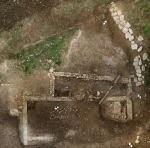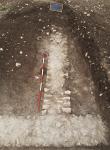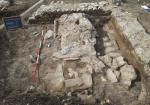Summary (English)
This season’s excavations took place in the sector known by the toponym Pietrara. This constitutes an extension of the archaeological area that was opened in order to investigate structures that emerged during work on the drains belonging to a residence adjacent to the archaeological area. In fact, in 2014 another section of basalt paving belonging to the via Nomentum-Eretum and a drainage system made of tufa came to light. Further investigations in subsequent years identified a residential structure that is still being excavated.
This year’s excavations extended the investigation of rooms 1 and 2, which correspond with two separate construction phases, providing new data for the understanding of their plans and internal layout.
The north, west and east perimeter walls of room 1, which date to a first phase, had already been identified. This season, another wall on an east-west alignment dividing the room in two was found. Outside the room and abutting its west wall there was a semi-circular tile floor, which probably dates to this first phase or soon afterwards.In the full imperial period, the smaller room 2 was added to the north, making use of the north wall of room 1.
As things stand, it may be suggested that a hydraulic structure identified in the north-eastern corner of room 2 belongs to this second phase. Although further excavation is needed, the remains of cement and opus signinum, in addition to the presence of two small channels, together with materials for domestic and personal use (hair pins), suggest this could have been a forica. Only further investigation will be able to confirm, or otherwise, this first hypothesis.
- Tiziana Sgrulloni, Archeoclub d'Italia sede Mentana-Monterotondo
- Sara Paoli, Archeoclub d'Italia sede Mentana-Monterotondo
Director
- Tiziana Sgrulloni, Archeoclub d'Italia sede Mentana-Monterotondo
Team
- Walter Benedetto Pantano
- Roberto Civetta
- Sara Paoli, Archeoclub d'Italia sede Mentana-Monterotondo
Research Body
- Archeoclub d'Italia sede Mentana-Monterotondo
Funding Body
- Archeoclub d'Italia sede Mentana-Monterotondo






![Download [PDF]](/excavation/skins/fasti/images/results/download_sml.png)

